The past 24 hours in the Ukraine conflict – in fewer than 140 wordspublished at 22:55 Greenwich Mean Time 17 November
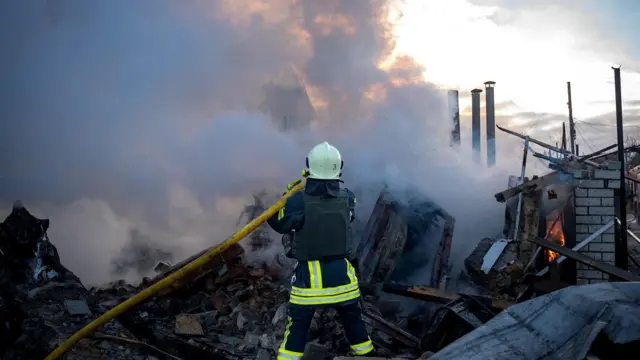 Image source, State Emergency Service Of Ukraine / Reuters
Image source, State Emergency Service Of Ukraine / Reuters
This evening, US media reported that President Joe Biden has approved Ukraine’s use of US-supplied long-range missiles to strike Russia.
Russia’s President Vladimir Putin hasn’t responded yet. Ukraine’s President Volodymyr Zelensky hasn’t confirmed or denied the US approval, but he said “the missiles will speak for themselves”.
Last night, a Russian attack on Saturday was the largest on Ukraine since early September, according to authorities and local media.
Zelensky said on Telegram that about 120 missiles and 90 drones were launched.The Russian defence ministry reported that it hit all its targets, focusing on “essential energy infrastructure supporting the Ukrainian military-industrial complex”.
This evening, Ukraine’s national grid operator Ukrenergo announced temporary power restrictions on Monday due to the damage.
Elsewhere, officials in Sumy, a city in northern Ukraine, reported that another Russian missile strike on Sunday evening killed eight people, including two children.
We’ll be pausing our live coverage shortly, but you can read more about how the events unfolded in our detailed report below:

The big question now is how will Putin respondpublished at 22:42 Greenwich Mean Time 17 November
Steve Rosenberg
Russia editor, reporting from Moscow
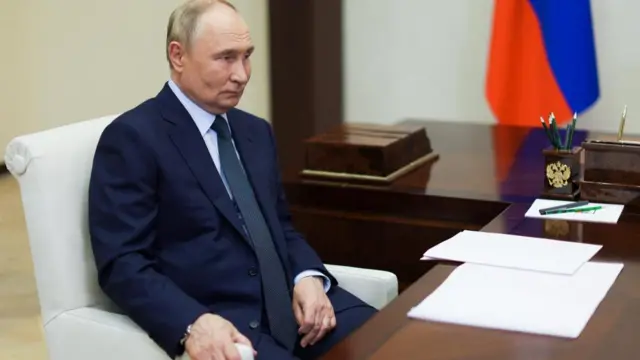 Image source, Reuters
Image source, Reuters
There doesn’t seem to be a sense of surprise here in Russia at reports of US President Joe Biden giving Ukraine the green light to use America’s long-range missiles to strike Russia.
So far, the only reaction in Russia is from senior Russian politicians, who are expressing a lot of anger.
The head of a pro-Kremlin party has warned of serious escalation and serious consequences, and a senior Russian senator has described this as a step towards a world war.
But what counts in Russia is what President Vladimir Putin says – and he’s not said anything yet.
Over the last few months, Moscow has been sending signal after signal to the West: don’t remove your restrictions on the use of your long-range weapons, don’t allow Ukraine to strike deep into Russian territory with those weapons.
In September, Putin said if that was allowed to happen, he would view it as the “direct participation” of Nato countries in the war in Ukraine and that it would change the “nature of the conflict”.
Putin announced imminent changes to Russia’s nuclear doctrine – which is the document that sets the conditions under which Russia may use a nuclear weapon. This was interpreted as sending a message to the West to not let Ukraine use the West’s long-range weapons to strike Russia.
It was Biden who made this decision but President-elect Donald Trump will take his place in the White House in January – it may play into Putin’s calculations as he tries to decide how he will respond.

War in Ukraine expected to be high on G20 agenda tomorrowpublished at 22:24 Greenwich Mean Time 17 November
James Landale
Diplomatic correspondent, reporting from Rio de Janeiro
 Image source, Reuters
Image source, Reuters
The US decision to allow Ukraine to fire its missiles deeper into Russia means the war will rise fast up the agenda at tomorrow’s G20 summit.
Leaders are arriving in Rio for the annual gathering of the world’s most powerful economies.
The Brazilian hosts want to talk about plans to tackle poverty and hunger, boost climate finance and reform international institutions. Yet diplomats now expect the war in Ukraine to dominate more discussions in the margins of this gathering.
All eyes will be on how Sergei Lavrov, Russia’s foreign minister, responds – he is coming to Rio de Janeiro instead of President Putin, who faces the risk of arrest on behalf of the International Criminal Court for alleged war crimes in Ukraine.
The Brazilians may dust off their six-point plan for peace that they are pushing along with China.
The complication is that this summit is taking place as the world is in a holding pattern, awaiting the arrival of Donald Trump in January.
The US President-elect is expected to push hard for some kind of political settlement in Ukraine. And the fear among diplomats is that fighting may escalate in the short term as both sides try to improve their positions before any kind of ceasefire.
Once again Ukraine is likely to overshadow another international summit, something that may test the patience of countries which want to talk about other issues such as the climate crisis and global economic reform.
Eight killed in new Russian strike on Ukrainian city – officialspublished at 22:18 Greenwich Mean Time 17 November
As we cover President Biden’s approval of using long-range missiles, officials in a Ukrainian city report that a Russian missile strike on a residential area has killed eight people.
The regional prosecutor’s office in the city of Sumy says at least 10 high-rise buildings and vehicles were damaged. They also state that the attack killed eight people, including two children, and that 20 local residents sought medical help.
This attack on Sumy comes after a massive assault Ukraine faced the night before, as we’ve reported earlier.

Biden’s decision has wider repercussionspublished at 22:09 Greenwich Mean Time 17 November
Paul Adams
Diplomatic correspondent, reporting from Dnipro, Ukraine
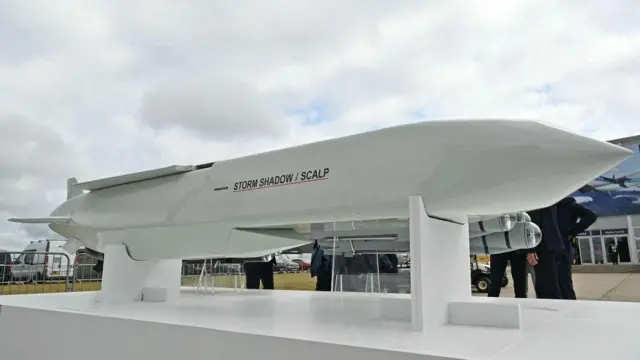 Image source, Getty Images
Image source, Getty Images
There is another knock-on consequence to Biden’s decision: It will finally enable Britain and France to grant Ukraine permission to use long range Storm Shadow missiles inside Russia.
This is something Kyiv has also been pressing for, arguing that to prevent Ukraine from hitting targets over the border is akin to tying one hand behind its back.
With a green light from Washington, London and Paris, airfields and key logistics hubs deep inside Russia will now come within Ukraine’s range.
Washington’s decision on ATACMS is couched in terms of being limited to the defence of Ukrainian forces inside the Kursk region.
In effect, the Biden administration is telling Kyiv that it will support its efforts to hold on to the small chunk of Russian territory it currently occupies, as a powerful bargaining chip for any possible negotiations in the future.
In September, Vladimir Putin warned that Nato would be in direct conflict with Russia if Ukraine used long-range Western missiles to strike inside Russia. That challenge is about to be put to the test.
Are North Korean troops in Russia?published at 22:03 Greenwich Mean Time 17 November
 Image source, Getty Images
Image source, Getty Images
More now on the North Korean troops that have entered the war for Russia and likely were a factor in Biden’s decision, per the Polish foreign minister.
In October, South Korea’s spy agency said North Korea had sent troops to fight with Russia in Ukraine – an allegation that came after Ukraine’s President Volodymyr Zelensky said he believed 10,000 North Korean soldiers could join the war.
US officials told the Reuters news agency on 4 November that North Korean troops were engaged in combat in the Kursk region of Russia, which is near the border between Russia and Ukraine.
Seoul, however, said at the time that it did “not believe [troops on both sides] engaged in direct combat”, but that there was an “incident” involving a small number of North Korean soldiers “near the frontline”.
In North Korea itself, it was announced this week that its leader, Kim Jong un, had signed a decree ratifying a mutual defence treaty with Russia, which was approved in June at a summit in Pyongyang with Russian President Vladimir Putin.
LISTEN: What does this decision mean for Ukraine?published at 21:54 Greenwich Mean Time 17 November
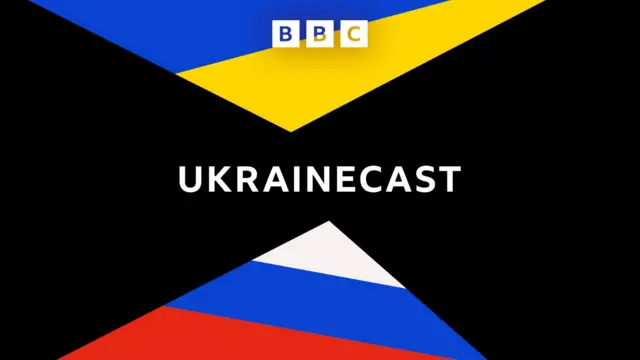
As we take in this news, the Ukrainecast team has put together an extra episode to discuss what the US approval for Ukraine to use these missiles on Russia might mean for Kyiv.
Presenters Victoria Derbyshire and Vitaly Shevchenko also look into why President Biden has chosen to make this decision now.

How North Korea factored into this decisionpublished at 21:39 Greenwich Mean Time 17 November
Jonathan Beale
Defence correspondent
UK defence officials and Ministers have been making the case for Ukraine to be permitted to use western-supplied, long-range missiles to hit targets inside Russia for months. But they were not willing to act alone – and had been waiting for the White House to change its mind.
That change of mind has been prompted by the arrival of North Korean troops in Russia’s Kursk region. Last week, western intelligence officials said it had altered the mood in Washington, though at the time they were not willing to say whether it might lead to a change in policy.
The significance of the change in policy on long range weapons will be as much symbolic as strategic. Ukraine has been given limited quantities of the weapons – hundreds not thousands. US military officials have long argued that one weapon system cannot win the war, and that many key Russian targets – such as airfields – will still be out of range. Russia has already moved its jets further from the border.
The US still appears to be placing caveats on the use of its long-range missiles – limiting their use to the Kursk region.
It highlights a history of hesitancy – Washington has only been willing to take incremental steps in upping the ante against Moscow. The Biden administration has often had to be cajoled by allies to do more. It’s Europe, not America that first argued for western tanks and jets to be sent to Ukraine.
But this is still a significant psychological boost for Ukraine at a time when its defences have been crumbling. Kyiv has been conducting its own long-range strikes with domestically produced drones. Now it won’t be doing it on its own.

Will Starmer follow Biden’s lead?published at 21:26 Greenwich Mean Time 17 November
Vicki Young
Deputy Political Editor
With President Biden’s choice allowing Ukraine to use long-range American missiles against Russia, the UK Prime Minister now has his own incredibly significant decision to make.
He’s currently half way across the Atlantic on his way to the G20 summit in Brazil.
A few hours ago, Keir Starmer spoke to those of us travelling with him and made it very clear that he wants Ukraine to get as much support as it needs so that Russia doesn’t succeed.
The UK has given Storm Shadow missiles to Kyiv and President Zelensky has been pushing for permission to use them on Russian targets.
The PM highlighted the involvement of North Korean troops, who are now working with the Russians, and told us this had serious implications for European security. So far Downing Street has offered us no update on this breaking story.
‘Missiles will speak for themselves’: Zelensky acknowledges reports about long-range missilespublished at 21:08 Greenwich Mean Time 17 November
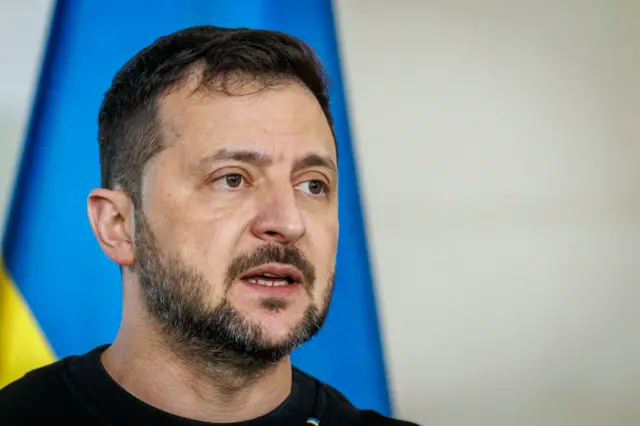 Image source, Getty Images
Image source, Getty Images
President Volodymyr Zelensky has acknowledged media reports about the use of ATACMS against Russia – but he did not confirm or deny if permission had been given to use them by the US.
In a video statement, the president said he had presented a “victory plan” to allies, which included “long range capability for our army”.
“Many in the media are saying that we have received permission to take appropriate actions”, he said. “But strikes are not carried out with words. Such things are not announced. The missiles will speak for themselves.”

What this means for Donald Trump’s hopes to end the warpublished at 20:53 Greenwich Mean Time 17 November
Rowan Bridge
North America correspondent, Washington DC
On the campaign trail Donald Trump would repeatedly use some version of his claim that he would be able to end the Russia-Ukraine war in 24 hours.
He’s suggested he could oversee a deal between the two sides but without going into any specifics. A research paper written by two of Mr Trump’s former national security officials in May suggested the US would continue to supply weapons but make it contingent on Ukraine entering peace talks.
And earlier this month, a former advisor to the campaign, Brian Lanza, told the BBC World Service Ukraine needed to recognise that Crimea was lost to Russia, and ending the war was about saving lives rather than winning back territory.
It’s possible this move could strengthen Ukraine’s position in any such negotiations if Donald Trump is successful in getting both sides to sit down together.
Polish FM welcomes Biden’s decision on long-range missilespublished at 20:44 Greenwich Mean Time 17 November
Poland’s foreign minister Radoslaw Sikorski applauded Biden’s decision to remove restrictions on Ukraine’s use of the missiles and noted it was a worthy response to recent attacks and the Kremlin enlisting the help of North Korea troops in the war.
“With the entry into the war of North Korea troops and [Sunday’s] massive attack of Russian missiles, President Biden responded in a language that V. Putin understands,” he wrote on X, external. “Strength deters, weakness provokes.”
What has US President-elect Trump said about the Ukraine war?published at 20:36 Greenwich Mean Time 17 November
Biden’s announcement is likely to have significant ramifications for his successor, Donald Trump, who will be returning to the White House this upcoming January.
The president-elect has been highly critical of the war – blaming Ukraine for the conflict and saying it has drained US resources. He’s consistently said he wants to end the conflict – claiming he could do so “in a day”.
When asked how, he suggested overseeing a deal, but has declined to give specifics.
Trump’s Democratic opponents have accused him of cosying up to Russian President Vladimir Putin, and claim his approach amounts to surrender for Ukraine and could endanger all of Europe.
Trump has also had a tumultuous relationship with Ukrainian President Volodymyr Zelensky. Trump was impeached in 2019 over accusations that he pressured Zelensky to dig up damaging information on the family of US President Joe Biden.
But despite years of differences, Trump has insisted he had a very good relationship with Zelensky.
When the pair met in New York in September, Trump said he “learned a lot” from the meeting and said he would get the war “resolved very quickly”.
Zelensky congratulated Trump’s White House win and said that both America and the world would benefit from his “peace through strength” approach.
What arms is the US providing Ukraine?published at 20:14 Greenwich Mean Time 17 November
The US has been the biggest arms supplier to Ukraine since the start of the conflict.
Between February 2022 and the end of June 2024, it delivered or committed weapons and equipment worth $55.5bn (£41.5bn), according to the Kiel Institute for the World Economy,, external a German research organisation.
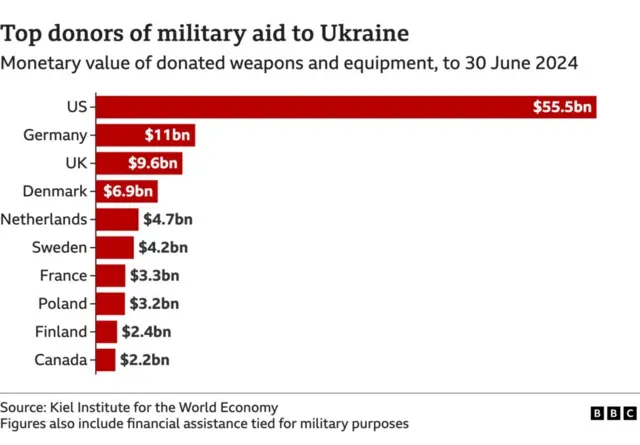
Other allies like Germany and the UK have given weapons and equipment worth $11bn and $9.6bn respectively.
The weapons have included aicraft, air defence, tanks and drones.
The UK has supplied Ukraine with long-range missiles called Storm Shadows, but hasn’t allowed Ukraine to use them against Russian territory.

Significance cannot be underestimatedpublished at 20:03 Greenwich Mean Time 17 November
Paul Adams
Diplomatic correspondent, reporting from Dnipro, Ukraine
This is a significant moment in the war.
Ukraine has been asking for months for permission to use ATACMS (Army Tactical Missile System) inside Russia.
It’s one of the most potent weapons yet provided to Ukraine, capable of firing long range missiles up to 300km (186 miles).
“This is a very important decision for us,” Serhii Kuzan, Chairman of the Kyiv-based think tank, the Ukrainian Security and Co-operation Centre, told me. “It’s not something that will change the course of the war, but I think it will make our forces more equal.”
Mr Kuzan said the decision had come just in time to counter the expected start of a major assault by Russian and Korean troops, designed to dislodge Ukrainian forces from the Russian Kursk region.
The assault is expected within days.
“That’s why this decision comes just in time. There are two days left,” he tells me, adding that much depended on what quantities of missiles have already been provided to Ukraine and whether the US shares intelligence information to enable the missiles to be used to the greatest effect.
What is ATACMS?published at 19:36 Greenwich Mean Time 17 November
 Image source, White Sands Missile Range Public Affairs
Image source, White Sands Missile Range Public Affairs
The MGM-140 Army Tactical Missile System, or ATACMS, is made by Lockheed Martin.
These missiles can reach up to 300km (186 miles) and are tough to intercept due to their high speed.
The US sent these weapons as part of a support package, and they’ve already been used at least once to hit Russian targets in occupied Crimea.
They allow Ukraine to strike deeper into areas held by Russia, targeting bases, storage facilities, and logistics hubs.
Russia has previously stated that this weaponry “will not fundamentally change the outcome” of the war, but Putin has cautioned the US against their use on Russian territory.
As a reminder, there is no formal confirmation by the White House or the Pentagon of the move which would be a major change of US policy.
US lifts ban on Ukraine using ATACMS against Russia, official confirmspublished at 19:27 Greenwich Mean Time 17 November
As we’ve been reporting, US media say President Biden has approved Ukraine’s use of long-range missiles supplied by the US to strike Russia.
The BBC’s US partner CBS News has this confirmation – a US official confirms the administration is lifting the ban on Ukraine using ATACMS for deep strikes into Russia.
Putin has previously warned against long-range missilespublished at 19:10 Greenwich Mean Time 17 November
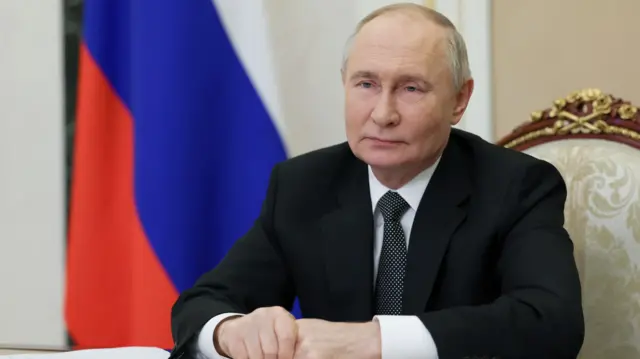 Image source, Reuters
Image source, Reuters
We’ve not heard from Russia’s Vladimir Putin yet about Ukraine’s use of long-range missiles, but he’s issued warnings about it before.
Back in September, Putin cautioned the West against letting Ukraine use their long-range missiles to hit Russian territory.
He stated that Moscow would see it as the “direct participation” of Nato countries in the Ukraine war, saying it would “substantially change the very essence, the nature of the conflict”.
“This will mean that NATO countries, the USA and European states, are fighting with Russia,” the Kremlin leader said.
Biden authorises Ukraine to use US long-range missiles to strike Russia – reportspublished at 18:45 Greenwich Mean Time 17 November
Breaking
US President Joe Biden has given the green light for Ukraine to use long-range missiles supplied by the US to strike Russia, according to US media reports.
There is no formal confirmation by the White House or the Pentagon of the move which would be a major change of US policy.
Ukraine’s President Volodymyr Zelensky has been urging for months for these restrictions on long-range missiles to be lifted, allowing Ukraine to target locations inside Russia.
Stay with us for more updates on this.
Russia targets energy infrastructure in widespread strikes on Ukrainepublished at 15:55 Greenwich Mean Time 17 November
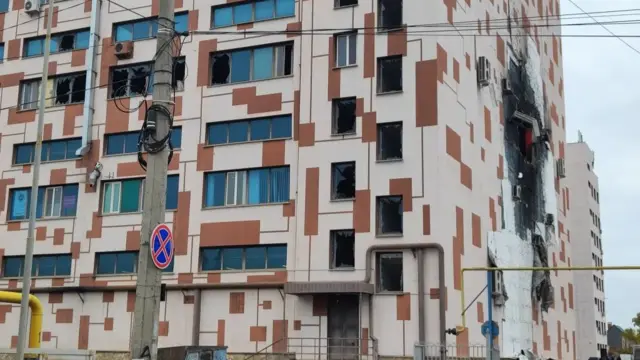 Image source, Getty Images / Mykolaiv Regional Military Administration
Image source, Getty Images / Mykolaiv Regional Military Administration
Russia launched one of the largest missile attacks since the start of the war targeting Ukraine’s energy infrastructure overnight. At least 10 people were killed.
Ukrainian president Volodymyr Zelensky described the air raids as a “massive combined strike on all regions” aimed at damaging the country’s energy infrastructure.
Russia said it targeted “essential energy infrastructure supporting the Ukrainian military-industrial complex”.
Neighbouring nations Romania and Moldova accused Russia of deliberately trying to impose freezing conditions on Ukraine over the winter, with a Ukrainian MP telling the BBC that Russia carried out similar attacks in the run-up to winter last year.
Ukraine’s largest private energy company said the strikes caused “significant damage” to its thermal energy plants and some areas were cut off from the electricity grid as a consequence.
Odesa region Governor Oleh Kiper said there had also been disruptions to heat and water supplies, although the latter was gradually being restored
We’ll be pausing our live coverage shortly but you can read more on how the events unravelled in our colleague Tom McArthur’s story.






